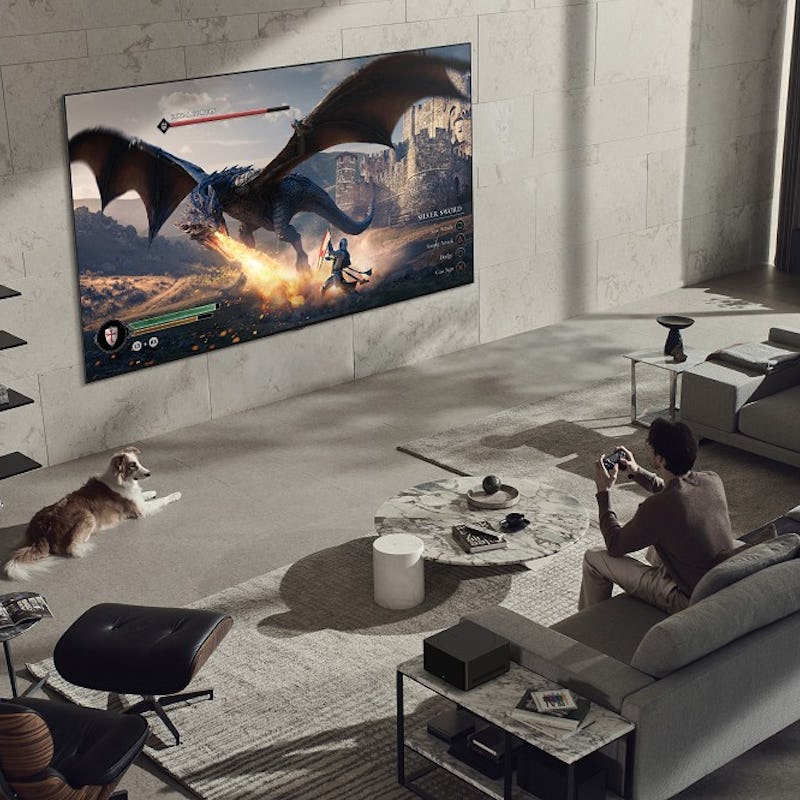Wireless TVs won CES 2023
LG's new Signature OLED TV, which receives signals wirelessly, is the perfect mix of futuristic and practical.

Despite the name, CES isn’t just about consumer electronics — it’s about ideas, man.
Sometimes those ideas are good, sometimes they’re outlandish, sometimes they’re, um, whatever this is. Often, at least in my book, the best CES concepts, prototypes, and products have a touch of all of the above, and the one product that really gave us the full spectrum of wow, what, and why is LG’s new wireless OLED TV.
Wireless TVs are (almost) exactly what they sound like: TVs that receive audio and video signals through a transmitter box as opposed to your traditional cable connections.
Why is that something you’d want, you ask? Well, if you’re like me, the thought of looking at a rat’s nest of HDMI and power cables is almost enough to make your face turn green. I hate messy cords.
LG’s working on a wireless future. This could be you — well, the $10 million loft version of you, anyway.
Obviously, LG’s TV can’t eliminate the cords entirely, but its box solution allows you to stash all those evil wires in a more convenient location (inside a cabinet perhaps), away from the naked eye of your living room watching/gaming experience.
I know what you’re thinking: what’s the caveat? And that’s actually the best part — there pretty much isn’t one, or at least not one that’s disqualifying.
LG says its transmitter can handle 4K resolution at 120Hz, which is more than enough juice for gaming and watching hi-def shows and movies, not to mention about the same standard as most of LG’s high-end TVs. LG even says you can stash its transmitter box up to 30 feet away from the monitor itself, giving you plenty of room to work with.
You are going to have to like big TVs, though. This bad boy is an eye-watering 97 inches, which maybe is not an ideal size for your standard living room, but will appease people who want a colossal screen. And yes, it does still have a power cord, though LG wisely stashed it into the TV’s stand so you can covertly plug it in.
Even with those small drawbacks noted, LG’s wireless TV pretty much achieves its goal seamlessly, and at a level high enough that makes it hard to ignore for serious cord-haters with enough money. There’s no current cost for the TV, but experimental LG TVs like its LG Signature OLED R cost half a Mercedes Maybach.
Enter: Displace
While LG claims to have developed the world’s first wireless OLED TV, it wasn’t without competition at CES 2023. Inverse’s Ian Carlos Campbell got a firsthand look at another company whose sights are fixed in the same direction: Displace.
Displace, an upstart, is gearing up to offer a similar product with a few notable twists. The biggest difference is Displace’s reliance on batteries as opposed to a power cord — a feature that makes its TVs truly wireless.
Displace’s wireless TV is definitely more wireless than LG’s, but is for risky early adopters only.
As you might imagine, using batteries, though the best way to eliminate cords altogether, will come at a convenience cost. If you were to use Displace’s TV for six hours per day, the company says you would have to charge the TV’s batteries once per month. That’s not the worst tradeoff in the world, but the thought of going to use your TV only to discover it’s actually dead might be more annoying than you think.
Also, Dispalce’s TVs, which will cost about $3,000, take the wireless concept a step further with how the TV is mounted. Its TVs fix to the wall using a vacuum. Displace is pretty confident about its tech’s ability to reliably suction a high-end TV to any wall, but as we noted in our CES coverage, the reality is a bit scarier. During Inverse’s demo, we watched the TV crash to the ground while Displace’s team attempted to suction one to a piece of glass. Maybe those wall mounts aren’t such a pain after all...
Future or faker?
Clearly, wireless TVs have not fully arrived in the same way “lifestyle” TVs like Samsung’s Frame have, but as an inkling of what the future of cord-hiding can look like, it’s hard not to be excited.
And as popular as Samsung’s Frame has been, the prospect of having to cut a hole into your wall and run cable behind (which is how the TV and its port terminal are meant to be installed) really puts a damper on the prospect of owning one — especially if you don’t actually own the walls you’re meant to be drilling into.
LG and Displace have followed Samsung’s idea to its logical destination, which is almost eliminating cords completely. It’s hard to say how that vision will pan out and whether wireless TVs will actually catch on the way Samsung’s Frame has, but that’s the joy of CES: there’s enough proof to make you believe, but enough concept to keep you guessing.
INVERSE brings you everything from the fun and futuristic world of consumer technology at CES 2023. For all the latest technology coverage from the show, go to the INVERSE CES 2023 hub.